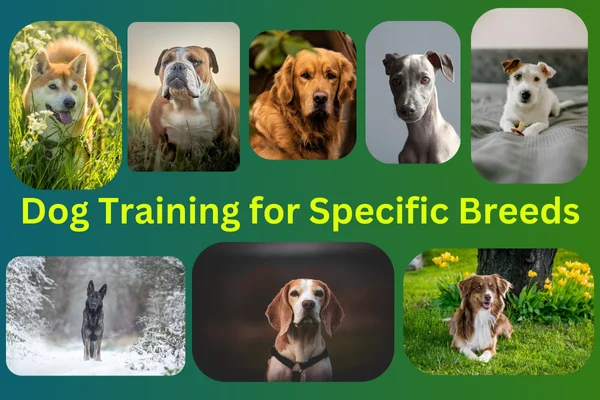Dog Training for Specific Breeds: What You Need to Know

Dog training can be challenging, but understanding your dog’s breed can make the process smoother. Different types have unique characteristics, and a method used for one type may not suit another. This post lays out in a simple way that you can understand how dog training varies by breed. Tips and tools are offered to effectively train your dog, regardless of breed. So read till the end without skipping.
“Brainy Buyz:” We are always with you to make it easy to choose “Wise purchases that make your life easier.” Our service of bringing you such important information is 100% free. If you purchase by visiting a link in the post, It helps cover the cost of our foods, drinks & bills. I appreciate your help.
Why Breed-Specific Training Matters
Each breed of dog is developed for specific tasks. For example, Border Collies are known for herding cattle, while Labrador Retrievers are natural hunters. These traits affect how they respond to dog training. A high-energy breed may need more physical activity to focus during exercise, while a more relaxed breed may benefit from calm, structured sessions. Successful training can be done by understanding these differences and training the dog handlers.
Dog Training Basics for Different Breeds
No matter what breed of dog you have, the basics of dog training remain the same. Consistency, positive reinforcement, and patience are key. However, you might need to adjust your approach based on the breed’s energy levels, intelligence, and temperament. I posted earlier about how to train dogs exactly. It has been taught how to train a dog from A to Z. Click the link below👇.
Dog Training 101: Essential Tips and Gadgets for a Well-Behaved Pup >>>>>>


- High-energy breeds (e.g., Australian Shepherds, Jack Russell Terriers): These dogs need a lot of physical and mental stimulation. What they deserve are training tools that challenge the mind and body. Toys like the KONG Extreme Dog Toy or Outward Hound Puzzle Toy should be considered to keep them engaged.


- Stubborn breeds (e.g., Bulldogs, Shiba Inus) may require more patience. A clicker, such as the PetSafe Clik-R Dog Training Clicker, can help mark desired behaviors, making it easier for the dog to understand what’s expected.


- Sensitive breeds (e.g., Greyhounds, Whippets): These dogs may not respond well to harsh corrections. Gentle, positive reinforcement techniques work best. Harnesses like the PetSafe Easy Walk Harness are excellent for these breeds as they prevent pulling without causing discomfort.
Tailoring Dog Training to Specific Breeds
Understanding how to tailor dog training to your dog’s breed can save time and frustration. Here are some breed-specific tips:

- German Shepherds: Use a balanced approach with mental challenges and structured routines. The Educator E-Collar Remote Dog Training Collar is highly recommended for teaching off-leash control.

- Beagles: Beagles are scent hounds, which makes them easily distracted. Training Beagles requires patience and a strong recall command. Using a long leash like the Hi Kiss Dog/Puppy Training Leash can allow them to explore while keeping them under control.

- Chihuahuas: This breed of dog is small in size but has a brave and stubborn character. A firm, consistent training system based on rewards is best for them, and consider using Zuke’s Mini Naturals Treats as a lower-calorie option.

- Golden Retrievers: This breed is a friendly, happy dog and is generally easy to train. Their sociable nature means they thrive with positive reinforcement. Tools like the Dog Care Collar are excellent for basic commands and off-leash training.
Standard Training Mistakes by Breed
It’s easy to make mistakes in dog training, especially when you don’t consider the breed’s characteristics. Here are some common pitfalls to avoid:
- Not providing enough mental stimulation: Breeds like Border Collies need more than physical exercise. Lack of mental stimulation can lead to boredom and destructive behavior.
- Being too harsh with sensitive breeds: Breeds like Whippets don’t respond well to punishment. A gentle approach works best.
- Expecting the same results from every breed: Training a Basset Hound, a scent-driven breed, will be much slower than training a Border Collie. Be patient and adjust your expectations based on the breed.
I wrote a post about ten mistakes most people make when training dogs and what to do to avoid them. Read the link below to read it👇.
The Top 10 Mistakes to Avoid in Dog Training>>>>>>
Dog Training Tools and Products for All Breeds
Below, I have listed the top-quality dog training equipment you will need to train whatever dog breed you have. I promise your dog will be easy to train using this equipment.
- PetSafe Clik-R Clicker: Ideal for marking good behavior and reinforcing commands.
- Educator E-Collar Remote Collar: Offers excellent control, especially for off-leash training.
- KONG Extreme Dog Toy: Perfect for high-energy breeds that need to stay occupied during training.
- Zuke’s Mini Naturals Treats: Healthy, bite-sized treats for rewarding positive behavior.
- Hi Kiss Puppy Training Leash: Great for practicing recall with scent-driven breeds like Beagles.
Conclusion
Dog training is not one-size-fits-all, but identify your dog’s breed and train accordingly, as described in this post. Then, you and the dog can continue the training process without frustration and with good results. What breed is your dog? What questions do you have when training your dog? Comment below, and I will post about it.
I have posted a post on how to keep your dog happy; click the link below to read it👇.
Unlocking the Secret to a Happy Dog Smile: Top Products to Keep Your Pup Smiling>>>>
